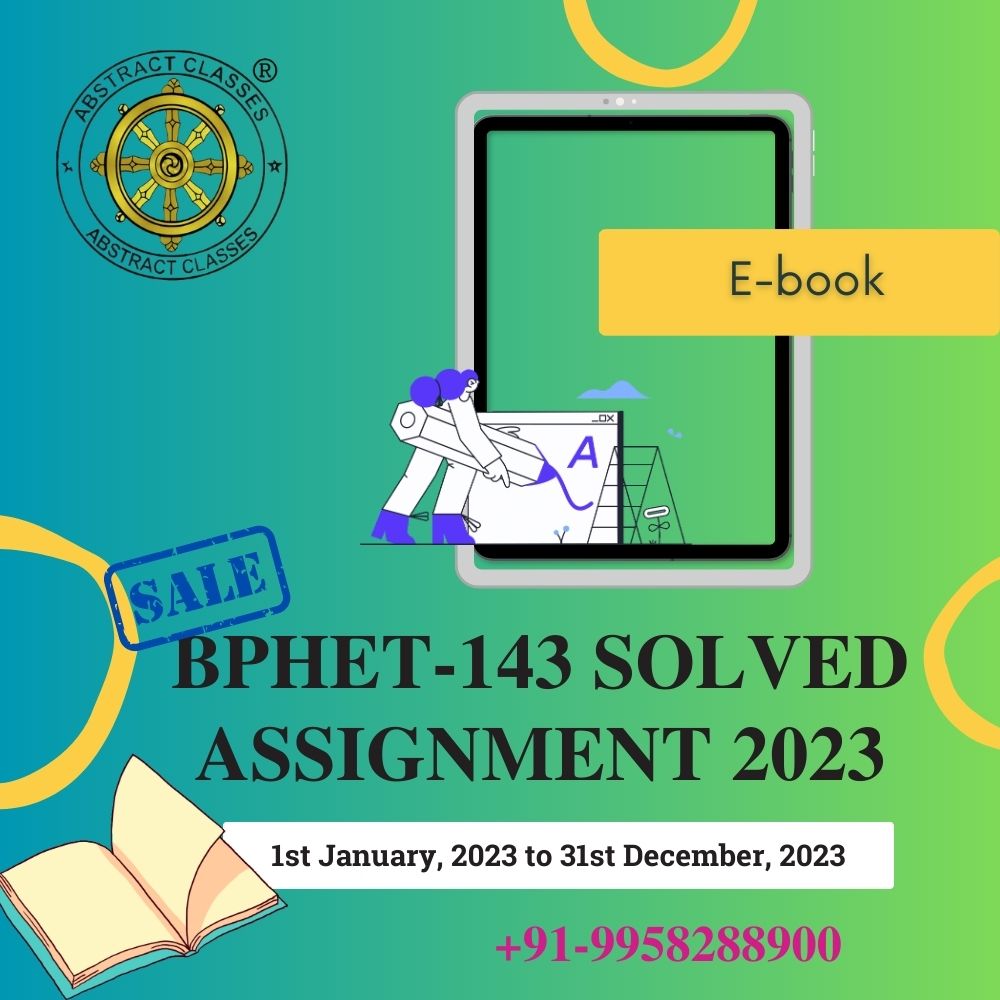
IGNOU BPHET-143 Solved Assignment 2023 | B.Sc. CBCS
₹101.00
Access via our Android App Only
Please read the following points before ordering :
Share with your Friends
IGNOU BPHET-143 Assignment Question Paper 2023
BPHET-143 (DIGITAL AND ANALOG CIRCUITS AND INSTRUMENTATION)
(Valid from 1st January, 2023 to 31 st December, 2023)
PART A
1. a) The intrinsic carrier concentration of a semiconductor is \(2.4 \times 10^{18} \mathrm{~m}^{-3}\). It is doped with a trivalent impurity with dopant atom density of \(3.4 \times 10^{19} \mathrm{~m}^{-3}\). The electron and hole mobilities are \(0.5 \mathrm{~m}^2 \mathrm{~V}^{-1} \mathrm{~s}^{-1}\) and \(0.3 \mathrm{~m}^2 \mathrm{~V}^{-1} \mathrm{~s}^{-1}\) respectively. Calculate its conductivity before and after the doping.
b) Explain the statement “Bipolar Junction Transistor is a current controlled device while Field Effect Transistor is a voltage controlled device”.
2. a) Discuss the three methods of biasing a BJT and compare their relative advantages and disadvantages.
b) Explain the two types of breakdown mechanisms observed in a zener diode.
c) \(h\)-parameters of a single stage CE amplifier are given as \(h_i=2 \mathrm{k} \Omega, h_r=5 \times 10^{-4}\), \(h_f=75\) and \(h_o=20 \mu \mathrm{AV}^{-1}\). Calculate \(A_i, A_v, Z_{\text {in }}\) and \(Z_{\text {out }}\) with \(r_L=5 \mathrm{k} \Omega\) and \(r_S=100 \Omega\).
3. a) Convert 0001010001001001 (BCD) into its binary equivalent and then divide it by \(1001_2\). Express the result in octal equivalent.
b) Draw the circuit to obtain a 2-input NOR gate using diodes, transistor and resistors.
4. a) Simplify the following Boolean expression and draw a logic gate circuit to implement the MSP.
\[
Y=(A+\bar{B})(B+\bar{C}) \overline{(A}+C)
\]
b) With the help of a suitable diagram, explain the subtraction of binary equivalent of decimal number 7 from binary equivalent of decimal number 12 using a 2’s complement binary adder-subtractor.
c) With the help of an appropriate diagram of a 4-bit binary adder explain the addition of 1110 and 0101.
PART B
5. a) Why is a class \(B\) amplifier more efficient than class \(A\) amplifier?
b) What will be the effect on the output of a push-pull amplifier if unmatched transistors are used?
c) An amplifier has maximum voltage gain of 1000 . Express it in dB scale. Calculate the gain at the cut-off frequencies on \(\mathrm{dB}\) scale.
6. a) Why are \(L C\) oscillators preferred over \(R C\) oscillators to generate high frequencies?
b) Why is a 2-stage amplifier required in Wien bridge oscillator in contrast to a single stage amplifier in the phase shift oscillator?
c) Draw the circuit of a Colpitts oscillator. Calculate its frequency of oscillation if value of both the capacitors is \(1 \mathrm{nF}\) and inductor is \(10 \mathrm{mH}\).
7. a) Explain the working of full wave bridge rectifier with the help of an appropriate diagram.
b) Design and draw a circuit of series pass voltage regulator to provide \(5 \mathrm{~V}\) output voltage and \(200 \mathrm{~mA}\) maximum load current using a silicon \(n-p-n\) transistor with \(\beta=100\). Assume the input unregulated voltage to be \(10 \mathrm{~V}\) and minimum zener diode current to be \(8 \mathrm{~mA}\). Specify the voltage and power rating of zener diode as well as value and power rating of the resistor used.
8. a) Compare the characteristics of IC \(741 \mathrm{C}\) with an ideal op amp.
b) Design an op amp comparator to provide \(+V_{S A T}\) output for input signal less than \(+1 \mathrm{~V}\) and \(-V_{S A T}\) output for input signal more than \(+1 \mathrm{~V}\).
c) Draw the output waveform indicating proper scales on the time and voltage axes for the given input waveform to the circuit shown in Fig. 1.

9. a) Draw the schematic diagram of cathode ray tube showing its major components and explain the functions of these components.
b) Design an astable multivibrator using IC 555 timer to generate a rectangular wave of \(75 \%\) duty cycle at \(20 \mathrm{kHz}\) frequency.
BPHET-143 Sample Solution 2023
Frequently Asked Questions (FAQs)
You can access the Complete Solution through our app, which can be downloaded using this link:
Simply click “Install” to download and install the app, and then follow the instructions to purchase the required assignment solution. Currently, the app is only available for Android devices. We are working on making the app available for iOS in the future, but it is not currently available for iOS devices.
Yes, It is Complete Solution, a comprehensive solution to the assignments for IGNOU. Valid from January 1, 2023 to December 31, 2023.
Yes, the Complete Solution is aligned with the IGNOU requirements and has been solved accordingly.
Yes, the Complete Solution is guaranteed to be error-free.The solutions are thoroughly researched and verified by subject matter experts to ensure their accuracy.
As of now, you have access to the Complete Solution for a period of 6 months after the date of purchase, which is sufficient to complete the assignment. However, we can extend the access period upon request. You can access the solution anytime through our app.
The app provides complete solutions for all assignment questions. If you still need help, you can contact the support team for assistance at Whatsapp +91-9958288900
No, access to the educational materials is limited to one device only, where you have first logged in. Logging in on multiple devices is not allowed and may result in the revocation of access to the educational materials.
Payments can be made through various secure online payment methods available in the app.Your payment information is protected with industry-standard security measures to ensure its confidentiality and safety. You will receive a receipt for your payment through email or within the app, depending on your preference.
The instructions for formatting your assignments are detailed in the Assignment Booklet, which includes details on paper size, margins, precision, and submission requirements. It is important to strictly follow these instructions to facilitate evaluation and avoid delays.
Terms and Conditions
- The educational materials provided in the app are the sole property of the app owner and are protected by copyright laws.
- Reproduction, distribution, or sale of the educational materials without prior written consent from the app owner is strictly prohibited and may result in legal consequences.
- Any attempt to modify, alter, or use the educational materials for commercial purposes is strictly prohibited.
- The app owner reserves the right to revoke access to the educational materials at any time without notice for any violation of these terms and conditions.
- The app owner is not responsible for any damages or losses resulting from the use of the educational materials.
- The app owner reserves the right to modify these terms and conditions at any time without notice.
- By accessing and using the app, you agree to abide by these terms and conditions.
- Access to the educational materials is limited to one device only. Logging in to the app on multiple devices is not allowed and may result in the revocation of access to the educational materials.
Our educational materials are solely available on our website and application only. Users and students can report the dealing or selling of the copied version of our educational materials by any third party at our email address (abstract4math@gmail.com) or mobile no. (+91-9958288900).
In return, such users/students can expect free our educational materials/assignments and other benefits as a bonafide gesture which will be completely dependent upon our discretion.
Related products
-
IGNOU Assignment Solution
IGNOU MEG-12 Solved Assignment 2022-2023 | MEG | A Survey Course in 20th Century Canadian Literature
₹101.00 Go to the App -
IGNOU Assignment Solution
IGNOU MEG-06 Solved Assignment 2022-2023 | MEG | AMERICAN LITERATURE
₹101.00 Go to the App -
IGNOU Assignment Solution
IGNOU MEG-05 Solved Assignment 2022-2023 | MEG | LITERARY CRITICISM & THEORY
₹101.00 Go to the App






